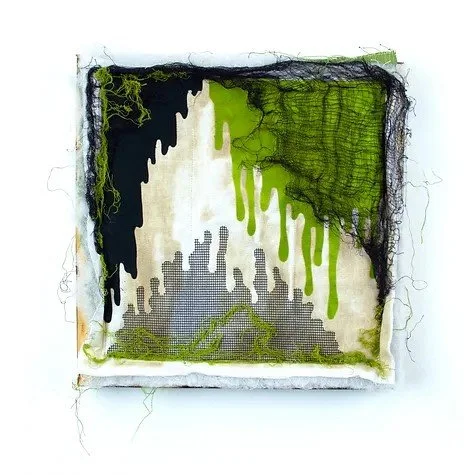MARISSA SHELL
Marissa Shell
Re-Wilding, 2023 (ongoing)
Each Panel, 10” x 10”
Installation Sizes Variable
Reclaimed Quilted Panels, Appliquéd Fiberglass Mesh, Dyed Cheesecloth and Cotton Fabric, Heat and Bond Adhesive, Felt, High Gloss Vinyl, Thread, Invisible Thread, Chain, Paper, Laser Cut Vinyl and additional Mixed Media
Contained, 2023
SIzes Variable (12" x 12" x 3") and (8" x 8" x 3")
Sandblasted Reclaimed Pine, Aluminum Mesh, Vinyl Insect Screen, Vinyl Sheeting, Dyed Polyester and Cotton Quilt Batting, Dyed Cheesecloth, Chain, Crystal Rhinestones
MAY 3rd - 31st, 2024 | SNAP SPACE GALLERY
About the Artist
Marissa Shell was born in New York City where she lived and worked prior to moving to the Kansas City area to pursue her MFA at The University of Kansas. She is a former Studio Fellow at the Charlotte Street Foundation in Kansas City, MO and is currently a studio resident at InterUrban ArtHouse in Overland Park, KS. She teaches Foundations and Fibers at The University of Kansas, Rocky Mountain College of Art and Design, and Johnson County Community College.
Artist Statement
Earth is changing at an astonishing rate. The result of this is a modified ecosystem, and a transmuted world. I am moved by these alternative landscapes. Neatly plowed crops and monoculture on country farm roads are orderly, uniform, and visually aesthetic. An aerial view at night of cities lights against black top and asphalt of a bustling metropolitan sprawl is bedazzling. A brick wall and trees covered in English Ivy is lush and vividly green. However, there is a poignancy in this seemingly beautiful and picture-perfect scenery. They are derivatives of excessive anthropological activity that are markers of our sovereignty over our surroundings. The allure of this new biosphere represents our desire and ability to control everything around us for luxury, comfort, and convenience. My work speculates a future planet where biological and synthetic matter is inextricably combined. Plants and soil may or may not be organic. Rocks and geological formations may no longer be composed of minerals and volcanic deposits but are amalgamations of industrial matter instead. Water may be seemingly present but could also be a mirage. A hybrid of perceived life forms, and imaginary relics composed of a variety of materials, are what one will find in my hypothetical ecosystems. I explore the possibilities of what the world might look like in a distant future following the eradication of humans. Visually intriguing surfaces made from discarded, found, and other acquired materials allude to hybridity. Sewing, burning, weaving, and sandblasting indicate decay and decomposition and our desire to want to fix and repair. My intricate textures and patterns are seductive and lush, embody the richness and complexity of the earth, and are informed by the artifice of the contemporary landscape.
Re-Wilding, 2023 (ongoing)
Inspired by human structures overgrown with vegetation, these embroideries investigate how the elements and nature inevitably undo human efforts to control our environment. The disparity created by the combination of soft organic threads and hard-edge industrial materials, the deteriorated and distressed nature of the substrates achieved through staining, burning, and unraveling, and recognizable patterns used for building, sewing, and other decorative purposes, embody the cycle of anthropological activity and the process of natural decomposition. The meticulous and steady process of building up layers and textures stitch by stitch and their ongoing growth alludes to the slow but gradual and perpetual decay facilitated by the elements and the wilderness that inevitably contradict human inclinations to want to fix, build and construct
Contained, 2023
These miniature environments are meant to appear as if they were ecosystems "contained” inside of a defined and controlled space. Each box is made from reclaimed wood that have been weathered and treated to emulate the processes and visual effects of decomposition and decay. They are made up of a variety of materials such as fibers, metal, gems, and paper, and are made using methods such as burning, felting, and dyeing.
Created as a continuation from another body of work, Re-Wilding, they are inspired by the visual aesthetics of dilapidated, abandoned barns, silos, sheds, and other man-made edifices that we might see along rural highways and country roads. Overgrown with weeds and eroded by the elements, these dilapidated structures are a visual reminded of nature’s capabilities to reclaim what was once unaltered by humans. Their presence is the evidence of human existence and tells a story of a species that has completely transformed the contemporary landscape.
Each box contains rich textures that look like natural forms made from man-made materials. Synthetic products look seemingly organic, and organic materials are carefully constructed to create architectural interiors. The visual combination of forms that appear to have evolved over time made using industrialized products are seductive, and their opulence suggests an otherworldly biome. My dioramas are windows into these hypothetical worlds where biomatter may or may not be organic and are a physical speculation of what one might find in a futuristic planet.













